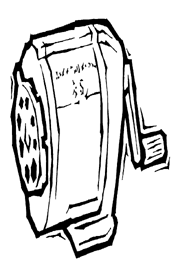 |
 |
 |
Brian takes the helm to learn what moves a riverboat.
Segment Length: 7:15
 |
 |
 |
Brian takes the helm to learn what moves a riverboat.
Segment Length: 7:15
Fill a glass with ice and water. Place it in direct sunlight. Stir the mixture. Measure the temperature of the water and record it. Every five minutes, stir the mixture and measure the temperature again. Keep recording your results for 20 minutes after all of the ice has melted. Graph your results. What happened? How does your graph change after the ice melts?
What is energy? Name things you use in everyday life that need energy. How are these items powered? How do you think this power is made? What do you think is the best source of energy?
Do you think one form of energy can be converted into another? Give some examples. Make a list of the different kinds of energy and then what each kind can be converted to.
What happens to energy after you've "used" it? For instance, when you drive a car and then park it, where does the energy go? Have you exhausted the source? Does a parked car with a full tank of gas have energy?
We think of energy in many different ways. You need energy to go to school, play soccer, or carry groceries. People need energy to drive cars and cook food. But whatever you think of when you think of energy, it is really just the ability to do work.
Energy can change from one form to another. It can be stored (as potential energy) or it can be used in motion, heat, or electromagnetic radiation.
In a steam engine, fuel (such as oil, gas, coal, or wood) is burned to heat water. The unburned fuel has chemical potential energy. As it burns, the fuel's potential energy is released as thermal energy (heat). The thermal energy is absorbed by the liquid molecules in the heated water, exciting them enough so they can break away from the liquid pool. After breaking away, they shoot into the space above the liquid. When this happens, we say that the liquid has "vaporized," or changed its state, turning into steam.
The fast-moving vapor molecules can hit objects hard and often, causing a lot of pressure against whatever they hit. This pressure can be used to do work such as pushing on the blades of a turbine, or pushing on the base of a piston. The thermal energy has become mechanical energy, allowing the machine to do work.
One type of piston drives a steamboat. Steam pushes the piston one way. Then that steam is released and new steam enters the other side, pushing the piston in the other direction. The piston pushes a long arm, called a pitman arm, which turns the paddle wheel. The paddle wheel pushes against the water, moving the boat forward. The steam in the system is cooled, heated again, and reused.
Steam engines were the first engines. They changed the way we work. Since their invention, people have discovered other ways of converting energy and now steam engines are used less.
Ardley, N. (1990) Hands-on science: Muscles to machines.
New York: Gloucester Press.Comstock, H.B. (1993) An illustrated guide to steam locomotives.
Sykesville, MD: Greenberg Publishing.Coy, P. (1993, Oct 18) A steam engine smaller than an ant's whisker.
Business Week, p. 67.Gardner, R. (1987) Energy projects for young scientists.
New York: F. Watts.Peterson, R. (1995, June) Masters of invention; Men of power.
Boys' Life, p. 20.Rutland, J. & Nash, D. (1987) The age of steam. New York: Random House.
On-line renewable energy education module:
http://solstice.crest.orgNational Resource Energy Laboratory:
http://www.nrel.govInternational Stationary Steam Engine Society
Box 311
Nescopeck, PA 18635
(717) 752-2279

Design a machine that turns the crank on a manual pencil sharpener.
One big challenge engineers face when designing a machine is how to transfer one kind of motion to another. For instance, on a steamboat, the piston moves back and forth, but it drives a paddle wheel around in a circular motion.
First, think about what kinds of motion are needed to do different tasks. What kind of motion is needed to open and close a garage door? To turn the wheels on a car? To operate an elevator? Now, design your own machine that transfers one kind of motion to another.
(This is a partial list -- use whatever you think will work to make this machine.)

Fill a 2-liter plastic soda bottle one-quarter full of hot (not boiling) water. Screw the cap on tightly. Submerge the bottle in ice-cold water. Watch the bottle. What happens? Why? Now submerge the bottle in a bath of very warm water. What happens now? Why?

Fill a small bottle (200 ml or 3/4 cup) three-quarters full of cool water. Stick a drinking straw through the top and hold it in place with modeling clay. make sure no air can get out of the bottle except through the straw. Warm up the bottle with your hands or by placing it in a tub of warm water. What happens? Why?

Fill a margarine tub half full of water. Snap the lid firmly in place. Put the covered container in a microwave for about 3 minutes, until the water boils. What happened? Why? Use hot pads to take it out and be careful not to get burned!
Tapes of this episode of Newton's Apple and others are available
from GPN for only $24.95.
Please call 1-800-228-4630.
For information on other Newton's Apple resources for home and school,
please call 1-800-588-NEWTON!
 We encourage duplication for educational
We encourage duplication for educational
non-commercial use!
Newton's Apple is a production of KTCA Twin Cities Public Television.
Made possible by a grant from 3M.
Educational materials developed with the National Science Teachers Association.